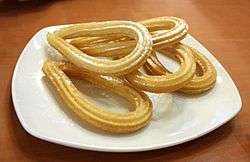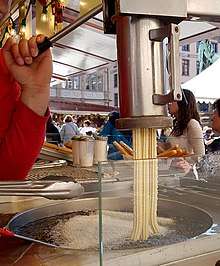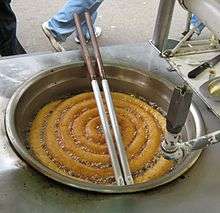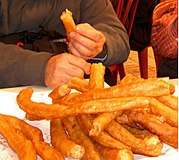Churro
A churro (Spanish pronunciation: [ˈtʃuro], Portuguese pronunciation: [ˈʃuʁu]) is a fried-dough pastry—predominantly choux—based snack. Churros are traditional in Spain and Portugal, where they originated, as well as in the Philippines and Ibero-America. They are also consumed around the world, especially in the Southwestern United States, France, and other areas that have received immigration from Spanish and Portuguese-speaking countries. In Spain, churros can either be thin (and sometimes knotted) or long and thick, where they are known as porras or jeringos[1] in some regions. They are normally eaten for breakfast dipped in champurrado, hot chocolate,[2] dulce de leche or café con leche. Sugar is often sprinkled on top. In Spain, Hispanic America and Brazil, the name churro is used.
 Churros | |
| Alternative names | Tejeringos |
|---|---|
| Type | Fried dough |
| Course | Breakfast, lunch, dinner, snack |
| Place of origin | Spain or Portugal |
| Serving temperature | Hot |
| Main ingredients | Flour |
In Portugal, churros are sold as a Spanish specialty.[3] There is a slightly different snack, called porra (Portuguese pronunciation: [ˈpoʁɐ]), which is filled with cream or jelly, similarly to other doughnuts in Portugal.[4] The Portuguese farturas (also very similar to churros) are the dominant dough in Portugal.[5]
History
The origin of churros is unclear. One theory suggests the concept was brought to Europe from China by the Portuguese.[6] The Portuguese sailed for the Orient and as they returned from Ming-dynasty China to Portugal, they brought along with them new culinary techniques, including altering dough for youtiao, also known as yóuzháguǐ in southern China which bears a resemblance to the churro. The new pastry was soon introduced to Spain, where it was modified to have the dough extruded through a star-shaped nozzle rather than pulled.[7]
Another theory is that the churro was made by Spanish shepherds to substitute for fresh baked goods. Churro paste was easy to make and fry in an open fire in the mountains, where shepherds spend most of their time.[8][9]
Not dissimilar from a recipe with flour and water fritter from Apicius' Roman cookbook and even older Greek ones, forms of fried dough have been around in the Mediterranean basin since ancestral times.[10]
Etymology
According to the Diccionario de la lengua española, ‘churro’ is a Spanish onomatopoeic voice.[11]
Preparation


Churros are fried until they become crunchy, and may be sprinkled with sugar. The surface of a churro is ridged due to having been piped from a churrera, a syringe-like tool with a star-shaped nozzle. Churros are generally prisms in shape, and may be straight, curled or spirally twisted.
Like pretzels, churros are sold by street vendors, who may fry them freshly on the street stand and sell them hot. In Spain and much of Latin America, churros are available in cafes for breakfast, although they may be eaten throughout the day as a snack. Specialized churrerías, in the form of a shop or a trailer, can be found during the holiday period. In addition, countries like Colombia, Peru, Spain, and Venezuela have churrerías throughout their streets. In Portugal, they are commonly eaten at carnivals, fairs and other celebrations, where they are made freshly at street stands.
The dough is a mixture of flour, water and salt. Some versions are made of potato dough.
Variations
In Seville (Andalusia), the name "calientes" (meaning hot) or "calentitos de rueda" is sometimes used instead of the word churro. These tend to refer to the thicker variant, called porra. Calientes are usually fried in the shape of a continuous spiral and cut into portions afterwards. The center of the spiral is thicker and softer, and for many a delicacy in itself. The standard "churro" is also sold under the name "calentitos de papas", the name referring to the softer mashed potato–like texture.[12][13][14]
In parts of Eastern Andalusia, a much thinner dough is used, which does not allow for the typical ridges to be formed on the surface of the churro. The final result therefore has a smooth surface, and is more pliable and of a slightly thinner diameter than standard Spanish churros. Another difference is that sugar is never sprinkled on them, because the flavour is not considered suitable.
Filled, straight churros are found in Cuba (with fruit, such as guava), Brazil (with chocolate, doce de leite, among others), and in Argentina, Bolivia, Peru, Chile and Mexico (usually filled with dulce de leche or cajeta but also with chocolate and vanilla). In Colombia and Venezuela, churros are glazed with arequipe and sweetened condensed milk. In Spain, a considerably wider diameter is used to accommodate the filling. In Uruguay, churros can also come in a savoury version, filled with melted cheese.
In the Philippines, churros are typically straight, or bent into U-shapes or circular shapes. They are usually dusted with white sugar. Churros are almost always eaten with tsokolate drinks (a pairing known as churros con tsokolate), which can also serve as a dip. They are popular during the Christmas season.[15][16][17]
Churros in American theme parks and street fairs are most often rolled in cinnamon sugar or other flavored sugars.
- Churros drizzled with chocolate
 "Tejeringos" or "Calentitos", an Andalusian variation of the churro
"Tejeringos" or "Calentitos", an Andalusian variation of the churro
See also
- Andalusian cuisine
- Awwamaat
- Beignet
- Buñuelo
- Chakli
- Cuisine of the Community of Madrid
- Jalebi
- List of fried dough foods
- List of doughnut varieties
- Loukoumades
- Puff-puff, similar Nigerian recipe
- Tulumba
- Youtiao
- Zalābiya
- Zlebia, the same sweet in the Maghreb (North Africa)

References
- Miguel, Amando de (28 January 2008). "Variaciones regionales del habla popular". Libertad Digital.
- "When Miami Temps Plunge Below 60, It's Time For Hot Churros". NPR.org.
- "Churro". Priberam Dicionário.
- "Cinco placas portuguesas que são muito estranhas para brasileiros". Folha de S.Paulo. 17 November 2015. Retrieved 17 July 2020.
- "Você já comeu porras?". Conexão Portugal.
- Cite web|url= https://www.foxnews.com/lifestyle/the-hidden-history-of-churros%7CTitle=The Hidden History of Churros|website=Fox News
- "Churros: a secret history". Retrieved 2011-10-16.
- "Churro Encyclopedia". Archived from the original on 2011-09-29. Retrieved 2011-12-27.
- "Churros: The Hidden History". The Huffington Post. 2011-08-18. Retrieved 2011-10-16.
- Randolph, Mike (17 June 2020). "The complex origin of beloved churros". BBC.
- Cite web|url=https://dle.rae.es/churro%7Cwebsite=REAL ACADEMIA ESPAÑOLA
- Díaz, Ana (2012-10-31). "Calentitos versus churros". ABC. Retrieved 19 June 2014.
- "Una de calentitos". Toda una amalgama. 18 October 2013.
- "La muralla duda: rueda o papa". Diario de Sevilla. 18 May 2009. Archived from the original on 27 August 2014. Retrieved 19 June 2014.
- Veneracion, Connie. "The Spanish Influence on Filipino Cuisine". The Spruce Eats. Retrieved 14 December 2018.
- Aranas, Jennifer (2012). The Filipino-American Kitchen: Traditional Recipes, Contemporary Flavors. Tuttle Publishing. ISBN 9781462904914.
- "How to Cook Churros con Tsokolate with Cocoa Tablea Drink". Asian in America. Retrieved 14 December 2018.
External links

